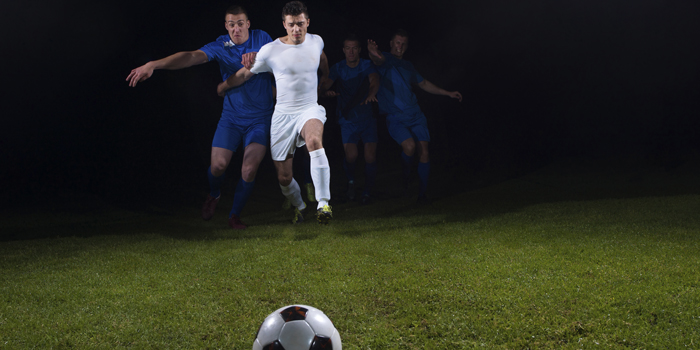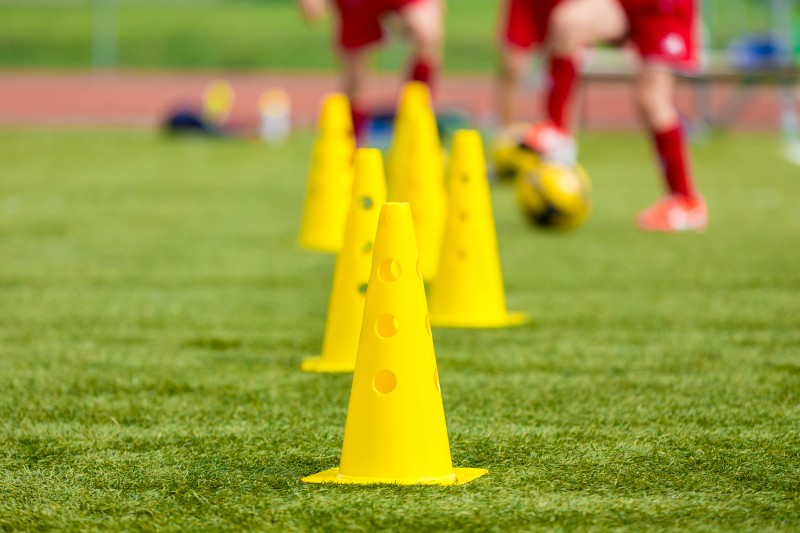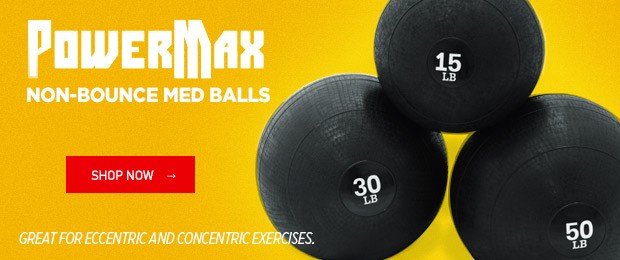
Agility is a term we hear when speaking about sport performance training. It is often affiliated with true athleticism outside of just brute strength in the weight room. Perhaps you’ve seen the video of an athlete moving through the agility ladder with his feet hardly visible because they are moving so fast. This remains the common mainstream perception of agility training. Does this, however, actually make athletes more agile on the field?
Let’s first define agility. One definition from the National Strength and Conditioning Association is “the ability to explosively break, change direction, and accelerate.”Now, we can see how it applies.
RELATED: The Agility Ladder — Useful Tool or Waste of Time?
The common criticism of ladder and cone drills from strength and conditioning coaches is that they don’t simulate field play. An athlete must change directions in reaction to something else. The ladder and cone drills are preconceived in that the athlete knows exactly where he or she is going from start to finish. In contrast, in actual gameplay, an athlete must react to an external stimulus and change directions on a spur-of-the-moment decision. What most coaches will do then is come up with drills that do incorporate change based on reaction. I tend to go a step further and say that agility is NOT something that can be trained in a weight room or conditioning setting. Here’s why.
To understand how agility training would play into a program, let’s make sure that we understand the difference between general physical preparedness(GPP) and specific physical preparedness(SPP). In most sports, GPP can be considered all of the work done in the weight room and conditioning. Becoming generally faster, stronger, more explosive, more mobile, etc., can all be transferable to any sport and therefore falls under the GPP category. SPP should be considered everything done in practice, drills, or even games. SPP develops very specific, situational, physical feats. For example, in the weight room, I as the strength and conditioning coach can train a quarterback to achieve better lower body strength to push off the back foot and to develop rotational core power. Both of these are attributed to throwing strength. However, I would not attempt to coach the specific throwing mechanics. This remains the job of the quarterback’s coach.
Image credit: matimix © 123rf.com
Now, we can look at agility and how it applies to gameplay. As opposed to jumping in a rack and squatting, agility in sports is very situational. A running back avoiding a tackler, a basketball player dodging defenders toward the basket, or a defender mirroring an offensive player in any sport can be considered agility. I consider all of these situations to be in the SPP category, and they can be developed only in practice or during a game.
Let’s take a look at this in detail. During gameplay, many factors come into play that shape how athletes must move, speed up, slow down, change directions, cut/shift/juke, and so on. We will use a football play as an example, as I think it best illustrates my point that no two moments in sports are exactly the same. Say that the running back is getting a carry between the guard and tackle. The number of situations that can occur are endless, but here are just a few:
- The back sprints directly through the hole into the linebackers and secondary.
- The hole takes time to develop, so the back must start, slow down, then speed up through the hole, all in a straight line.
- A defender quickly breaks through, and the back must decelerate and change directions laterally(either go in the same general direction or press the outside foot and bounce out the complete opposite direction).
- Runs uncontested through the line must evade a linebacker either way. Which way he goes can depend on the approach of that linebacker.
The list could clearly go on forever, but the idea is that so many things can happen in a matter of seconds during game actions. The separation of the agile versus non-agile players in these situations comes down to instincts as much as it does athleticism. I don’t think throwing med balls or Swiss balls at players as they run, forcing them to reactively dodge them, has any carryover to situational gameplay. Opposing players decelerate/accelerate at you. They move laterally in front of you, move diagonally, or backpedal. Players may reach out with arms/legs/sticks(lacrosse/hockey). A simple ball rolling in a straight line and at a fixed speed does nothing to mimic this.
Going back to the job of the strength coach, we can even look at the “training economy,” or simply, what value are you getting out of your training? Unless you are a professional athlete, chances are you are an athlete in school with many other things going on in life. Therefore, you need to make the most of your time in the gym. For example, for athletics, I usually have three hours per week with an athlete, broken up into three days. Therefore, time in the gym is valuable. The most important focus points for offseason GPP training will always be good warmups, mobility, maximal strength, power, and general speed work. I feel that athletes are much better served not using time on agility drills with little to no carryover.
So, how do players become more agile? To me, it simply comes down to just doing your sport. We can go back to the beginning, where we talked about SPP and how it involves everything in practices and games. It really is a simple as that. Agility, as it relates to your sport, is something you simply have to do repetitively, with high levels of specificity.
Header image credit: dotshock © 123rf.com
Michael Mercer is a certified trainer and the owner of Canton Barbell in Canton, Ohio. He received his bachelor’s degree in exercise science from the University of Akron in 2015. After graduation, he worked as an exercise specialist with Akron General until branching out to become a private sector trainer. Michael has worked with more than 100 clients and athletes. The athletes with whom he has worked include lacrosse, football, baseball, and tennis players as well as Spartan Race athletes.












I appreciate you writing this article. Really made me think about most bang for your buck working in the private sector with limited time to spend with each athlete.
I do have a question.
Do you feel that teaching proper decel position/how to be most efficient in movement going into acceleration has some merit? Or do you feel those things will naturally occur through time spent improving strength and power and letting the reactional nature of sport run its course?
Thanks again. I love getting challenged on my current beliefs. Just out here trying to get better.